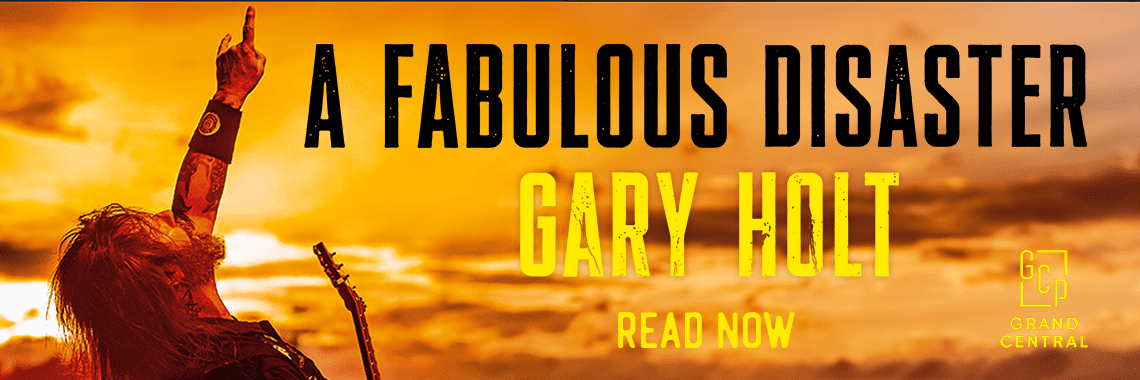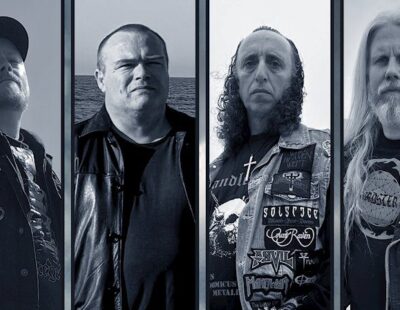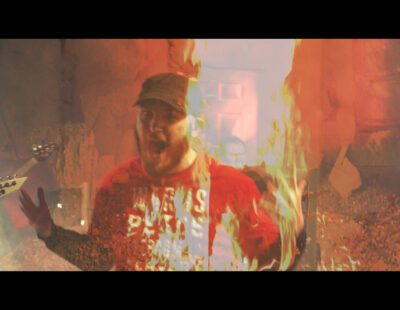One of the cool things about Italian facerippers the Secret is that they take the humanity and worthiness out of hardcore and replace it with a dark, doomy, occultist vibe. Like, their whole deal is really dark, shredding hardcore, but there’s that malevolence there that’s a product of jamming Darkthrone up loud and a total fascination with horror movies. It’s hardly unique in the Deciblog‘s warped dimenions, that some of the wrongdoers making music should find cinema’s extremities of decency to be a fertile place to sow ideas for songs, cover art and just, y’know, the general demeanour to maintain when dealing with the press/public. But in hardcore circles it’s rare enough to still be refreshing.
https://youtu.be/6nX-5alDQ14
When the Secret checked into Kurt Ballou’s GodCity studio, Salem, MA to record the bestial slab of ill-will and clandestine plot, Solve et Coagula, it was the sum total of the usual hardcore influences, a nod and a wink to black metal’s necro aesthetic, but most of all it had a nasty atmosphere. We caught up with Guitarist Michael Bertoldini while on tour with Tombs to talk about a subject not only close to his heart but on that’s integral to informing the Secret’s sound: Italian horror. Ketchup blood, village eccentrics, gone-bad priests, Satan and boobs… It’s got a lot to recommend it.
What are the main differences in style between Italian and U.S. horror movies?
Michael Bertoldini: “There are different kinds of Italian horror movies, like especially since the late ‘60s. We had this more satanic current of movies, especially the stuff influenced by the Rosemary’s Baby/Polanski kind of style, which is very, very interesting. They’re really not horror movies, like splattery stuff, they’re more like esoteric thrillers. There are two movies I really like from the late ‘60s and very early ‘70s: one is called Chi sei?, which means “Who are you?”, and it’s very much inspired by Rosemary’s Baby—it’s pretty much the same concept. But it’s still really cool, visually it’s a beautiful movie and I really like it. It doesn’t take place in Italy but it’s an Italian production. Probably, my favourite horror movie is from Pupi Avati, who is a horror director who started to do very different stuff, like comedies and stuff like that, but he started as a horror movies director, and this movie is called La Casa Dalle Finestre Che Ridono, which means, the house with the windows that laugh. It’s a very, very good movie. It takes place in Lido degli Scacchi, which is a small town in Emilio-Romagna, which is two hours south from where we are from.
“It’s about this painter who goes to this small town to restore it. There’s this huge painting by a local painter who went crazy, and the whole movie is really good because it is so unusual; it’s such an unusual location for a horror movie because it just takes place in the countryside, it’s a small town, everyone in the town is really nice at the beginning. The atmosphere gets more and more oppressive—it’s really cool because it represents really well the Italian society of that time, because people are really into the superficial, everyone wants everything to appear good, and they always hide the other side. He represents that in the movie really well. It’s something that was new for that time because we didn’t have any other important movies like that at that time. That’s probably my favourite.
“Another movie that I really love is Tutti i colori del buio (All the Colors of the Dark), it’s from another great director called Sergio Martino, and it follows a more satanic current. It’s a very psychedelic movie, visually, it’s very beautiful—there’s a lot of colors. And something that’s common to all of those movies from the ‘70s is that there’s a lot of nudity—hahaha!—in the movies and it’s kinda weird for that time because Italy used to be a very, very puritanical country—it was really shocking but people kinda liked that stuff, they went to the cinema to see it and a lot of those movies did really well.”
Do you think Italian horror films of that era had an atmosphere of their own?
MB: “I think so. I’m just talking about the atmosphere, those earlier movies just focused on the atmosphere and a good plot, and not on the special effects or anything like that—because, probably, the budget was so low. I think it was what made those movies something special. A little bit later, like in the early ‘70s, Dario Argento started directing his movies, and I don’t know if you know his movies but he started to do more violent thriller movies. He named those movies giallos, like it’s always pretty much the same story: there’s a killer killing the young, then the plot gets complicated. But after this, Dario Argento really changed the styles of those movies, because the movies became less focused on the plot as they were before, he found a new way of directing the violent scenes because he’s showing you the violence from the murderer’s perspective and this was something totally new.”
That’s what gets the censors excited because it’s dangerous…
MB: “I don’t know, ha! Maybe some people could relate to it but there was this kind of glorification of violence in his movies. I mean, those movies started being a little more splattery, more blood, more violence in general. I really like his [Argento’s] first work because I am not a fan of the movies he directed during the ‘80s. The giallos are good, in my opinion, everything up to Profundo Rosso (Deep Red) is awesome, like L’uccello dalle piume di cristallo (the Bird with the Crystal Plumage), 4 mosche di velluto grigio—they’re all great movies. And that stuff was unique back then.”
How important were Goblin to Argento’s work? Those soundtracks were amazing.
MB: “I think that what they’re doing is basically announcing the tension in the movies. If you listen to the Profundo Rosso soundtrack, it’s just crazy how they are able to jump to the very sinister, scary music which goes on when most of the violence/scary part is going on, and then they can do something totally different, writing songs that are basically love theme just to make the atmosphere relaxed. I think this is giving the movies a very good dynamic—the scary parts get scarier because it’s not like there’s scary music all the time.”
That’s so important—new horror all too often forgets that and just goes horrible/cruel for the whole way through and it’s difficult to have an affection for the characters.
MB: “It’s definitely a more European style to go deeper into the characters and stuff like that.”
How much effect did Catholicism have on Italian horror—was a lot of horror a rebellion against the Church?
MB: “I think that Catholicism really affected our whole culture, pop culture as well, and horror movies are part of the pop culture. Actually, there are a few movies that attack puritanism and Catholicism directly, like Non si sevizia un paperino, (Don’t Torture a Duckling), it’s one of my favorite Fulci movies. Lucio Fulci was famous for splatter stuff and zombies but this movies was one of his earlier ones and it’s always about the small town! Some weird stuff starts happening, some kid dies, and I don’t want to ruin the surprise for anyone who hasn’t seen the movie but it wasn’t that common back then to speak about priests who were weird or sketchy. It was the same with La casa dalle finestre che ridono, there are always priests—the figure of the priest is always very important in small towns in Italy. In the ‘70s they kind of, I dunno, had a political role. It was between the lines, it wasn’t explicit but they had a really important political power. It was a medium between the people and the authorities because people felt comfortable talking to them about their most personal things.”
Yeah, Confession is really brutal. It’s best to leave some things unsaid.
MB: “I never did it! Luckily my family wasn’t a Catholic family. There’s something weird about telling someone you really don’t know you’re most personal stuff. Definitely, Catholicism tried to scare people, like, ‘If you don’t follow our path you’re not going to do well.’ Hahaha! So yeah, I think these kinds of scary atmospheres are in pretty much in late ‘60s/early ‘70s movies, like with priests involved those movies became really weird.”
What about the influence of Profondo Rosso—do you see it in films such as Halloween and the Scream franchise?
MB: “I think Dario Argento definitely inspired a lot of American cinema, because the figure of the serial killer; he went really deep into it. Also, visually, like the perspective of the murderer is something that he started. And you mention Scream by Wes Craven; I know for sure that Wes Craven is a huge fan of Italian horror movies from the early ‘70s, he actually did a quote from La Casa Dalle Finestre Che Ridono in the first Nightmare on Elm Street, like when Freddie Kreuger is on fire there’s a quote from that movie.”
Do you see influences in some of David Lynch’s work, even though he’s not outright horror, he’s terrifying with that small town normality dynamic and the underlying evil?
MB: “I don’t know if David Lynch is influenced by that sort of thing but he could be. I mean, some of Sergio Martino’s films, he did all those movies that were sexually weird. There was a lot of sex and a lot of psychedelia in his movies. It’s something that is used a lot. Like sex and death; that stuff’s totally primitive, and so using such very primitive emotions is always something that can scare people or can provoke a very strong reaction.”
We haven’t even mentioned the zombies.
MB: “I like some zombie movies but to be honest I like the Romero movies first, like Dawn of the Dead, as it’s collaboration between George Romero and Dario Argento, and the soundtrack is from Goblin. It’s definitely one of the zombie movies that I definitely really like.”
What contemporary horror is exciting you?
MB: “Unfortunately not much Italian stuff. New horrors that I like? I really liked that Belgian movie called Calvaire. It’s pretty disturbing. It’s not original at all but it’s basically about a guy whose car breaks down in the middle of the forest, he gets in touch with this guy who lives in a cave, totally isolated from reality, and slowly the guy starts being really weird. I think the whole movie is all about small communities that want to preserve their identities from bigger cities…. A lot of weird stuff happens—it’s really about isolation, and how isolation can make beliefs and thoughts about reality change.”
What about this new reality style horror, that maybe started with the Blair Witch Project and is now in films like [REC]?
MB: “I really liked the first [REC], the plot builds on the tension, and the plot is actually pretty simple and boring but it’s a great movie because visually it is interesting; the perspective of the journalists, I think it’s very realistic, it looks real. The tension gets higher and higher throughout the movie. I really liked it. It was really creepy, I liked how they added that esoteric ending so it didn’t look like every other zombie movie or anything like that. I didn’t really like the second one.
MICHAEL BERTOLDINI’S TOP FIVE MOST IMPORTANT ITALIAN HORROR MOVIES.(NSFW, and apologies: finding English subtitled clips is like solving the Riddle of the Spinx)
La Casa Dalle Finestre Che Ridono (1970)
https://youtu.be/tfrRXmI7kgQ
Profondo rosso (1975)
https://youtu.be/mzOJ_63u3mM
Tutti i colori del buio (1972)
https://youtu.be/ZuGgtOb4Hmg
Il tuo vizio è una stanza chiusa e solo io ne ho la chiave (1972)
https://youtu.be/DF_25M-InQc
Non si sevizia un paperino (1972)
https://youtu.be/Q_p7wYPD0RA






